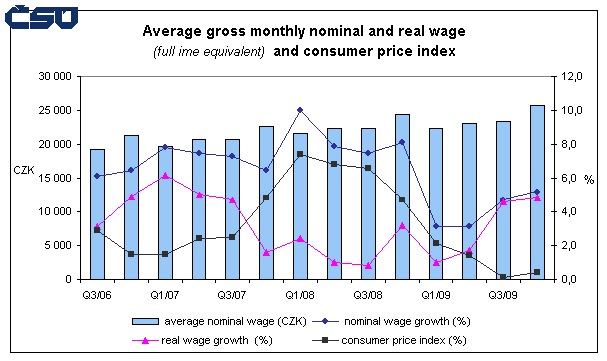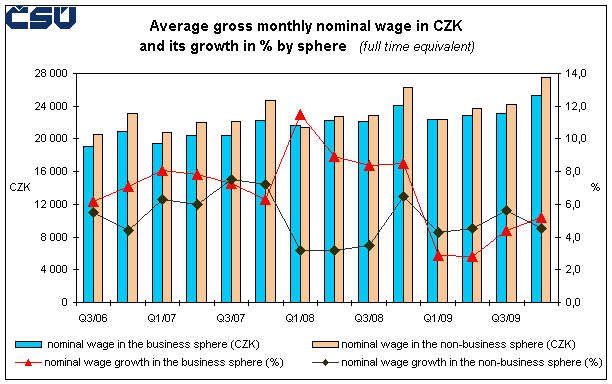Analysis of the development of average wages of employees - 4 quarter
Product Code: q-3134-09
There is no sign that the labour market in the Czech Republic saw a revival. The development is still dominated by a dramatic y-o-y drop of the registered number of employees (FTE): in Q4 2009 the total of 274 thousand employees (6.8%) were made redundant. The biggest loss of jobs was registered in all industries where 181 thousand employees, i.e. 13.5% were dismissed. The drop in the number of employees was more profound also in market services, the biggest number of jobs was lost in wholesale and retail trade; repair and maintenance of motor vehicles where 32 thousand of employees, i.e. 6.2% were dismisses and, relatively biggest numbers of redundant employees were recorded in 'administrative and support service activities’ where over 17 thousand of jobs (11.9%) were lost.
Total drop of employment in the business sphere by 282 thousand (8.5%) is partly slowed down by a moderate growth of employment in the non-business sphere by 8 thousand (1.2%) which is mainly due to the relocation of part of the dismissed to social beneficial work.
In wages a paradox growth was registered per employee on average (+5.2%) which, however, came mainly from transfers of employment structures reflecting the last year’s situation, i.e. dismissals of employees with lower wages, drop of sickness rate and payment of accumulated extraordinary remunerations by the year-end due to more favourable tax conditions. General increase of wages was rather an exception because of surviving unfavourable situation in majority of enterprises.
The real wage development was, in addition to the nominal wage growth, affected also by growing price level (inflation) measured by the consumer price index. In Q1 2008 the inflation hit its top (7.4%) and has been falling since to reach 2.1% in Q1 2009, 1.4% in Q2 and 0.1% in Q3. In Q4 inflation increased by 0.4%.
The total real wage in Q4 2009 increased, y-o-y, by 4.8%. In Q4 the business sphere saw an increase of the real wage by 4.8%, y-o-y, while the non-business sphere recorded a 4.1% growth.
Graph 1

Graph 2

The minimum wage showed no changes since January 2007 and accounts for CZK 8 000.
The nominal average gross monthly wage per natural persons in the sample survey 1 reached in Q4 2009 CZK 26 450, in the y-o-y comparison the increase made CZK 1 223, i.e. 4.8%. In the business sphere the average wage increased, y-o-y, by CZK 1 266 to CZK 26 602, in the non-business sphere by CZK 1 117 to CZK 25 957. In the business sphere the increase was 5.0%, in the non-business sphere 4.5%.
The difference between average wages calculated according to different concepts are due both to the inclusion of the below-limit businesses and also to the type of employment, i.e. full time equivalent, taken into the account (in the non-business sphere only the latter was observed).
Nationwide wage development is shaped mainly by the business sphere since their employees make more than 80%. While the wage development in the business sphere is used to be more fluent and is affected mainly by economic results of the companies, it is jump-like in nature in the non-business sphere because it depends on what the budget allows.
* * *
Over the year 2009 the number of employees (FTE) dropped by 239 thousand (5.9%) and the volume of wages decreased by 2.1%. With respect to the above, the average wage in the national economy accounted for CZK 23 598, which means an increase of nominal wage by 4.0% and real wage by 3.0%, compared to the previous year. Significant changes in the structure of employees took place affecting markedly the above indices which reflect insufficiently the actual development of wages. Detailed analyses of these changes will be possible when the results of structural wage statistics are available (approximately in May 2010).
In terms of individual economic activities (CZ-NACE sections) a drop of the average wage in two industries – 'mining and quarrying' (-4.4%) and 'accommodation and food service activities' (-0.6%) was reported and in 'other activities' stagnation was observed. By contrast, the biggest growth of average wages was registered in 'electricity, gas, steam and air conditioning supply' (+10.9%).
__________________________
1 The data refer to business sphere enterprises with 20+ employees (in financial and insurance activities irrespective of the number of employees) and all non-business sphere organizations.
